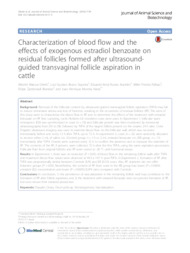Characterization of blood flow and the effects of exogenous estradiol benzoate on residual follicles formed after ultrasound-guided transvaginal follicle aspiration in cattle.
Characterization of blood flow and the effects of exogenous estradiol benzoate on residual follicles formed after ultrasound-guided transvaginal follicle aspiration in cattle.
Author(s): GHETTI, A. M.; SIQUEIRA, L. G. B.; ARASHIRO, E. K. N.; PALHÃO, M. P.; BRANDÃO, F. Z.; VIANA, J. H. M.
Summary: Abstract Background: Removal of the follicular content by ultrasound-guided transvaginal follicle aspiration (TVFA) may fail to induce immediate atresia and loss of function, resulting in the occurrence of residual follicles (RF). The aims of this study were to characterize the blood flow in RF and to determine the effects of the treatment with estradiol benzoate on RF fate. Lactating, cyclic Holstein-Gir crossbred cows were used. In Experiment 1, follicular wave emergence (D0) was synchronized in cows (n = 10) and follicular growth was then monitored by transrectal ultrasonography from D0 to D8, followed by TVFA of the largest follicle present on the ovaries 24 h later. Color Doppler ultrasound imaging was used to examine blood flow on the follicular wall, which was recorded immediately before and every 12 h after TVFA, up to 72 h. In experiment 2, cows (n = 22) were randomly allocated to receive either 2 mL of saline i.m. (Control group, n = 11) or 2 mL estradiol benzoate i.m. (EB group, n = 11) immediately after TVFA. Ovaries were scanned every 12 h to confirm the presence and to measure the diameter of RF. The contents of the RF, if present, were collected 72 h after the first TVFA, using the same aspiration procedures. Follicular fluid from original follicles and RF were stored at -20 °C until hormonal assays. Results: In Experiment 1, there was no reduction (P > 0.05) of blood flow in the remaining follicle walls after TVFA and maximum blood flow values were observed at 49.5 ± 19.7 h post-TVFA. In Experiment 2, formation of RF after TVFA was proportionally similar between Controls (5/9) and EB (5/10) cows. Also, RF diameter did not differ between groups (P > 0.05). Nonetheless, the content of RF from cows in the EB group had lower (P = 0.0004) estradiol (E2) concentration and lower (P = 0.0005) E2:P4 ratio compared with Controls. Conclusions: In conclusion, 1) the persistence of vascularization in the remaining follicle wall may contribute to the formation of RF after follicle aspiration, and 2) the treatment with estradiol benzoate does not prevent formation of RF, but does reduce their estradiol production.
Publication year: 2016
Types of publication: Journal article
Unit: Embrapa Dairy Cattle
Keywords: Doppler, Ovary, Ovum pick-up, Vascularization, steroidogenesis
Observation
Some of Embrapa's publications are published as ePub files. To read them, use or download one of the following free software options to your computer or mobile device. Android: Google Play Books; IOS: iBooks; Windows and Linux: Calibre.
Access other publications
Access the Agricultural Research Database (BDPA) to consult Embrapa's full library collection and records.
Visit Embrapa Bookstore to purchase books and other publications sold by Embrapa.

